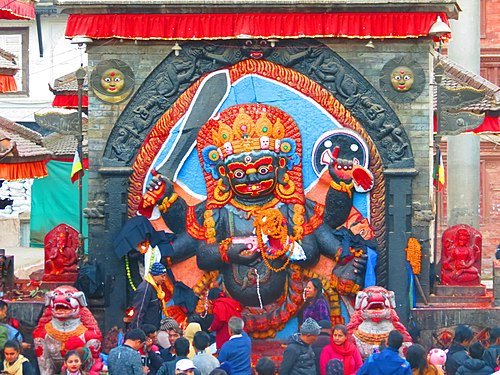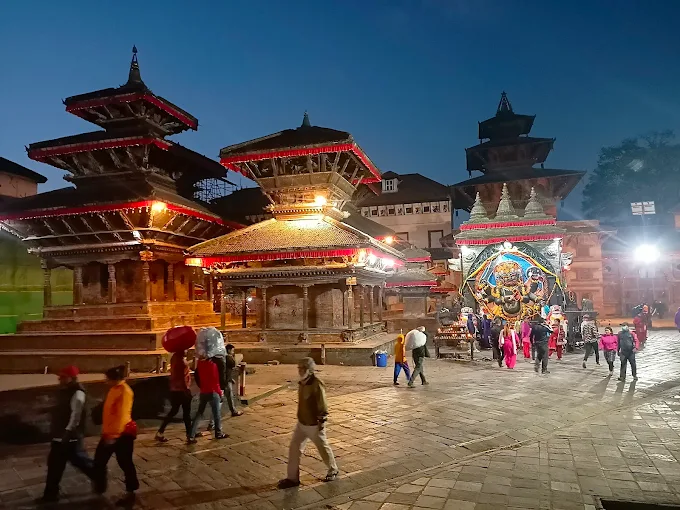
Kaal Bhairav
Kaal Bhairav is one of the most powerful and awe-inspiring shrines located within the historic Hanuman Dhoka Durbar Square, a UNESCO World Heritage Site in Kathmandu, Nepal. Dedicated to Lord Bhairav — the fierce manifestation of Lord Shiva this shrine is not just a religious landmark but also a cultural and historical symbol of Kathmandu Valley.
According to legends, the massive stone idol of Kaal Bhairav was discovered in a paddy field and later installed in the Durbar Square by the famous King Pratap Malla in the 17th century. The statue is said to have been carved out of a single stone, making it a masterpiece of ancient Newar craftsmanship.
Today, This temple continues to attract thousands of devotees, locals, and curious travelers who come to witness the divine energy of this imposing figure.
History of Kaal Bhairav
Discovery: The idol of Kaal Bhairav was found buried in a paddy field, though the exact date of its creation remains a mystery.
Installation: King Pratap Malla (reign: 1641–1674), a great patron of art and culture, had the idol placed at Hanuman Dhoka, the royal palace complex of the Malla kings.
Architecture: The statue is made from a single block of stone and depicts Bhairav in a fearsome form — large eyes, fangs, garlands of skulls, and holding various weapons.
Bhairav temple has long been regarded as the protector of justice. In the past, people in Kathmandu believed that taking an oath in front of Bhairav ensured absolute truth, as lying before the deity was said to bring dire consequences.
Religious and Cultural Significance
Fierce Form of Shiva: Bhairav represents the destructive and protective aspects of Lord Shiva. Kaal Bhairav, in particular, symbolizes time, death, and ultimate justice.
Guardian of Durbar Square: Locals believe that Bhairav protects Kathmandu Durbar Square and the Basantapur area from evil forces.
Oath-Taking Tradition: In ancient times, legal disputes were settled by making the accused swear in front of Kaal Bhairav. The belief was that Bhairav’s wrath would punish those who lied.
Festivals: During important Hindu festivals like Indra Jatra, Kaal Bhairav becomes a focal point of worship, with devotees offering flowers, tika, and traditional rituals.
Architecture and Idol Description
The idol of Kaal Bhairav is over 12 feet high and carved from a single black stone.
The deity is depicted with six arms, holding various weapons symbolizing power and justice.
The garland of skulls, protruding fangs, and wide-open eyes represent his fierce nature.
The idol is painted and adorned with offerings throughout the year, giving it an intimidating yet divine presence.
Visiting Bhairav in Kathmandu
Location: Basantapur Durbar Square (Hanuman Dhoka), Kathmandu.
Timings: Open daily from 10:00 AM to 5:00 PM.
Entry Fee: No separate fee is required to visit Kaal Bhairav, though international visitors must pay the entry fee to access Kathmandu Durbar Square.
Accessibility: The shrine is located within the main square, making it easily accessible on foot once you enter the complex.
Travel Tips
Best time to visit is in the morning or late afternoon to avoid heavy crowds.
Combine your visit with nearby attractions like Hanuman Dhoka Palace Museum, Kumari Ghar, and other temples in Durbar Square.
Respect local customs avoid touching the idol and follow traditional etiquette while offering prayers.
Photography is allowed, but always be mindful of devotees worshipping at the shrine.
Legends and Beliefs
It is believed that Bhairav can detect truth from lies. Anyone who dares to lie in front of the deity will face divine punishment.
Many locals still whisper their wishes and confessions near the statue, believing Bhairav listens and grants justice.
Some stories say that King Pratap Malla himself installed Kaal Bhairav to keep watch over his kingdom and protect the palace from evil.
FAQs
1. Where is Kaal Bhairav located?
Kaal Bhairav is located in Hanuman Dhoka Durbar Square, Basantapur, Kathmandu.
2. Who built Kaal Bhairav temple?
The idol itself is believed to be ancient, but King Pratap Malla installed it in the Durbar Square during the 17th century.
3. What is the entry fee to visit Kaal Bhairav?
There is no separate entry fee, but foreign visitors must purchase a ticket to enter Kathmandu Durbar Square.
4. What are the opening hours of Kaal Bhairav shrine?
The shrine is open from 10 AM to 5 PM daily.
5. Why is Kaal Bhairav famous?
Kaal Bhairav temple is famous for its fierce representation of Lord Shiva, its role in ancient justice systems, and its artistic depiction carved from a single stone.


